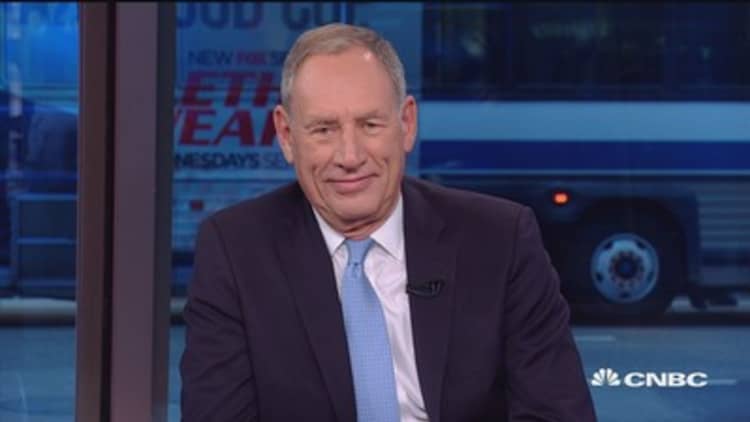Obamacare insurers are getting hit by a triple whammy from "special" customers — whose health costs are helping destabilize the program, setting the stage for higher premiums next year, a new report finds.
The analysis from health consultancy Avalere found that people who enroll in Obamacare plans during so-called special enrollment periods have continued to have higher health-care costs than people who sign up during the open-enrollment season.
It also found that such people are costing insurers extra money because a measurement used to calculate their predicted health benefit usage is low-balling what they actually end up using.
The disparity between the predictions and the reality means that insurers are getting less money than they should from an Obamacare program meant to lower financial risk for insurers covering higher-cost customers.
And Avalere's report said that special enrollment Obamacare customers on average spend just 3.6 months enrolled in a plan — less than half of the 7.8-months average for open-enrollment customers.
That shorter time span means that insurers are getting less in total premiums each year from their special enrollment customers than from their open-enrollment customers.

"Consumers enrolling through special enrollment periods have higher health-care spending than those picking a plan during open enrollment, and they are staying in the program for shorter periods of time," said Avalere President Dan Mendelson.
"This is one of the many technical problems that is presently destabilizing this program, and should be fixed by the [Obama] administration and the Congress to ensure continuity for patients," Mendelson said.
Avalere's report comes less than a month before the start of open enrollment in Obamacare plans. Many plans are set to raise their premium prices significantly higher than last year because they say that customers are using more health services than insurers had projected.
The Affordable Care Act requires most Americans to have some form of health coverage during the year or pay a fine. People who enroll in individual health plans to satisfy that requirement typically do so during open enrollment — which for 2017 will run from Nov. 1 to Jan. 31, 2017.
For most people, enrollment outside that period isn't allowed. However, the law does provide for special enrollment periods. Those periods are open to people with certain life events — marriage, divorce, change in household size, changes in residence — as well as to people who lose health coverage or who experience other factors.
In the first half of 2015, about 940,000 people signed up via a special enrollment on HealthCare.gov, the federal Obamacare marketplace that serves 38 states. That number represents 15 percent of the total number of people enrolled on HealthCare.gov by the end of that year.
In 2014, Avalere found, people who enrolled during open enrollment have average per-member, per-month health costs of $391. But special enrollment customers had costs of $454 per month — 16 percent higher than open-enrollment counterparts.
In 2015, open-enrollment customers had health costs of an average of $389 per month. Special enrollment customers' average costs were $407 — 4.6 percent higher.
Despite having higher actual health costs, the special enrollment customers had so-called risk scores that were significantly lower than open-enrollment customers.
"Risk scores represent a measure of predicted healthcare costs," Avalere's report noted. Low risk scores mean that a customer is expected to have low health costs.
But in 2014, special enrollment customers had risk scores that were 17 percent lower than open-enrollment customers, who used less health services as a group. The disparity grew last year, when special enrollment customers' risk scores were 20 percent lower than the open-enrollment group.
Under Obamacare's risk adjustment program, health plans with low risk scores give up some of their revenue to plans with high risk scores.
But Avalere's data suggest that risk scores do not "appear to be an accurate predictor of cost," said Elizabeth Carpenter, senior vice president at Avalere.
"The plan is getting paid less for people that are actually costing more," Carpenter said.
Carpenter said the fact that special enrollment customers as group tend to spend shorter periods of time enrolled in coverage than other people "could lead to some kind of issues in assigning a risk score" correctly to them.
She also said because "people who take advantage of special enrollment periods are potentially more likely to need health-care services," the shorter time span they are enrolled reduces the likelihood that insurance plans will recoup their costs by collecting premiums.
Asked about the Avalere report, U.S. Health and Human Services Department spokeswoman Marjorie Connolly noted that the Affordable Care Act barred insurers from discriminating against people who have pre-existing health conditions, and also banned plans from instituting life-time an annual caps on care costs. Both steps could have led to more people with health problems enrolling in plans than had before.
"The most recent data for 2015 on per-member costs in the individual market suggest that the ACA risk pool improved in 2015, an encouraging sign for the long-term health of the marketplace," Connolly said.
"Nearly all states are seeing continued enrollment growth in 2016, suggesting continued risk pool improvement for the marketplace going forward. And HHS continues to take actions to further strengthen the risk pool, including a series of actions to prevent potential misuse of Special Enrollment Periods."
HHS also noted that, as the Avalere report points out, the department has proposed making changes to the risk adjustment program that would address concerns about risk scores understating costs from part-year enrollees.


